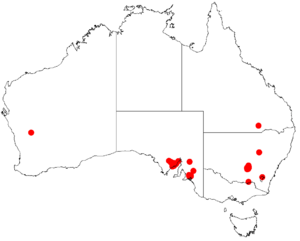Dagger-leaf wattle facts for kids
Quick facts for kids Dagger-leaf wattle |
|
|---|---|
| Scientific classification | |
| Genus: |
Acacia
|
| Species: |
rhigiophylla
|
 |
|
| Occurrence data from AVH | |
The Dagger-leaf wattle (scientific name: Acacia rhigiophylla) is a type of shrub. It belongs to the Acacia family, which is also known as wattles. This plant grows naturally in southern Australia. It gets its common name, "dagger-leaf," because its leaves are sharp and pointed.
Contents
About the Dagger-Leaf Wattle
This shrub is quite prickly and grows in a tangled way. It can reach a height of up to 3 meters (about 10 feet). Its branches have sharp, stiff parts called stipules, which are like small thorns. These stipules are about 1 to 2 millimeters long and are shiny brown.
The bark of the Dagger-leaf wattle is brown and can be rough or flaky, especially near the bottom of the plant. Like many Acacia species, it doesn't have typical leaves. Instead, it has phyllodes. Phyllodes are flattened leaf stems that look and act like leaves.
Phyllodes and Flowers
The phyllodes of the Dagger-leaf wattle are dark green and very stiff. They are usually shaped like a triangle or a square and are pointed at the end. Each phyllode is about 7 to 30 millimeters long and 1.2 to 2 millimeters wide. They have three to six clear veins running through them.
This wattle blooms between September and October. It produces bright yellow flowers that grow in simple groups called inflorescences. These flower groups are found on short stalks, only 1 to 2 millimeters long. The flowers form cylindrical spikes, which are about 0.5 to 1 millimeter long and contain 6 to 15 yellow flowers.
Seed Pods
After the flowers bloom, seed pods start to form. These pods are long and narrow, but they are a bit squeezed between each seed. The pods are very curved or even coiled, and they can be up to 5.5 centimeters long and about 2.5 millimeters wide. They have many veins running along them. Inside the pods, the seeds are oval-shaped and about 3 to 4 millimeters long.
The Dagger-leaf wattle is similar to another plant called Acacia colletioides. However, Acacia colletioides grows in many more places. Another plant, Acacia oxycedrus, has similar phyllodes but its flower groups are much longer.
How it Was Named
The Dagger-leaf wattle was officially described for the first time in 1855. Two scientists, George Bentham and Ferdinand von Mueller, worked together to name it. They published their findings in a scientific journal.
For a short time in 2003, a scientist named Leslie Pedley reclassified it under a different genus, calling it Racosperma rhigiophyllum. But in 2006, it was moved back to the Acacia genus, which is where it remains today.
Where it Grows
The Dagger-leaf wattle grows in separate areas of South Australia and New South Wales. This is called a "disjunct distribution," meaning its populations are not connected.
In South Australia, you can find it in a small part of the Eyre Peninsula and in the Murray region. It usually grows in open scrub-land areas. These are places with scattered shrubs and trees. It often grows alongside Eucalyptus socialis and Eucalyptus gracilis trees. It prefers to grow in specific types of soil, such as grey-brown loamy soils that contain lime, or hard, alkaline red soils.

